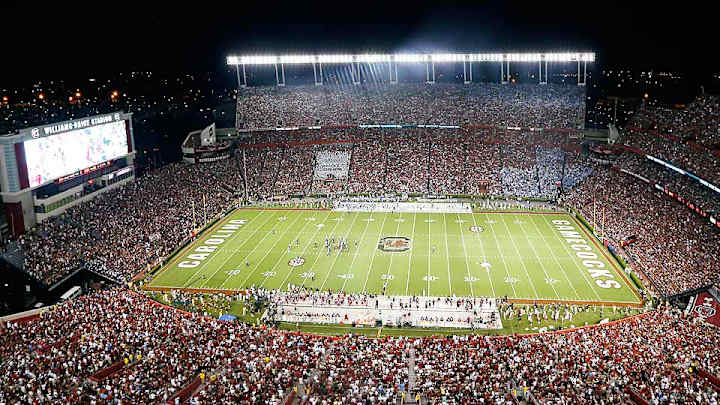Stadium Spotlight: Swaying in South Carolina's Williams-Brice Stadium

A little stadium sway never hurt anyone. Well, provided that structural supports get added in to make sure that movement isn’t too much for an 80-year-old football stadium.
South Carolina’s Williams-Brice Stadium, built in 1934 and now with a capacity of more than 80,000, needed a little help in the late 1980s to handle its raucous fans sitting in the then-new east-end upper deck.
“At that time, it was predominately students and young people sitting up there and they would all jump and sway at the same time with ‘Louie Louie’ and (the stadium) started swaying a little bit,” says Tommy Suggs, a Gamecocks player over 40 years ago and now a radio commentator for the team. “We want our fans to have a good time, and that is when they came up with the saying, ‘If it ain’t swayin’, we ain’t playin.’”
South Carolina added structural support to stadium’s upper deck to handle the movement, South Carolina athletic department spokesman Steve Fink tells SI.com
Georgia seeks payback for 2012 loss at South Carolina; Walkthrough
“It still moves a little on the press side when we get rockin’ and rollin’ with ‘Sandstorm,’” Suggs says about the team’s signature song. “We need it to sway a little bit.”
The boisterous 80,000-seat venue took time to build in Columbia. Originally known as Carolina Stadium, it was constructed in 1934 by the Works Progress Administration, seating 17,600. By the late ‘60s, the stadium started to grow, seating 43,000 and then 54,000 by the early ‘70s. By the mid-‘90s, additions had filled out the stadium, and now it stands as one of the 20 largest NCAA venues.
“It has always been a loud stadium because the sound tends to stay in it, which has been good for us,” Suggs says. “I think the place has always been a great place to play football.”
Recent renovations have modernized portions of the stadiums, including additional suites and an 11,000-square-foot banuet facility offering a unique view from the south end zone. South Carolina added a $6.5 million 36-foot by 124-foot video board two years ago.
• STAFF: SI's experts pick winners for UGA-S. Carolina, more Week 3 games
Structurally, the lower bowl nearly completely wraps the field, helping to keep noise encapsulated, and upper deck additions now fill both sidelines and one end zone.
But the stadium atmosphere extends beyond the concrete to the tailgating grounds outside -- the fairgrounds help by allowing plenty of space for fans. Suggs calls the environment beyond the seating bowl a trademark and says when the fans move inside they like to pack the stadium and get the noise ratcheted up early.
“Our fans are good football fans,” Suggs says. “It will be loud early, and our students have done a wonderful job. Our people have seen some good football here; they’ve seen some great football. They know it, like it and understand it and really enjoy rewarding the team and coaches by cheering.”
And when Darude’s “Sandstorm” comes on or the 375-member band gets rolling, you can still find some of that signature Williams-Brice Stadium sway.
Tim Newcomb covers stadiums, design and gear for Sports Illustrated. Follow him on twitter at @tdnewcomb.
